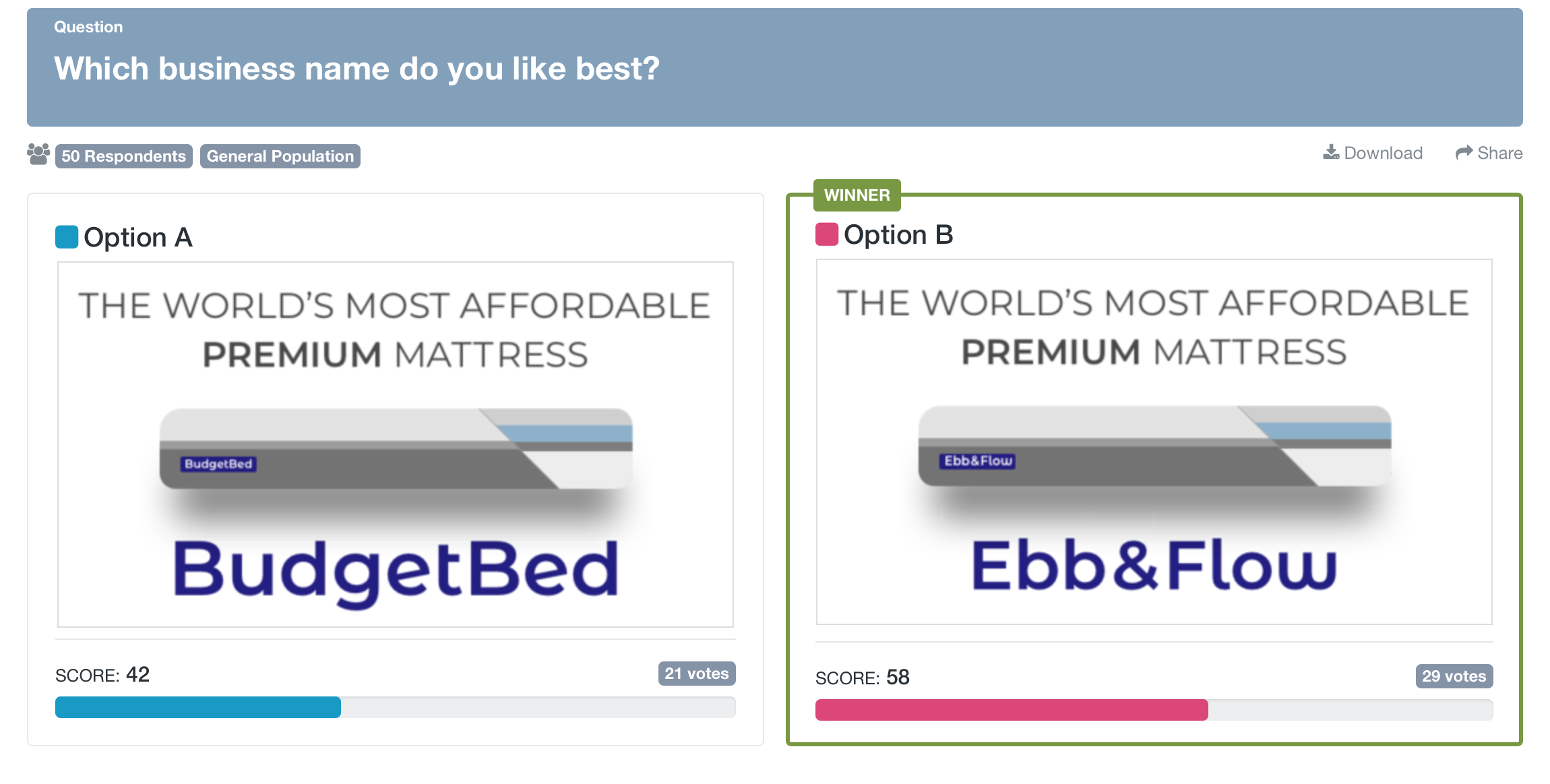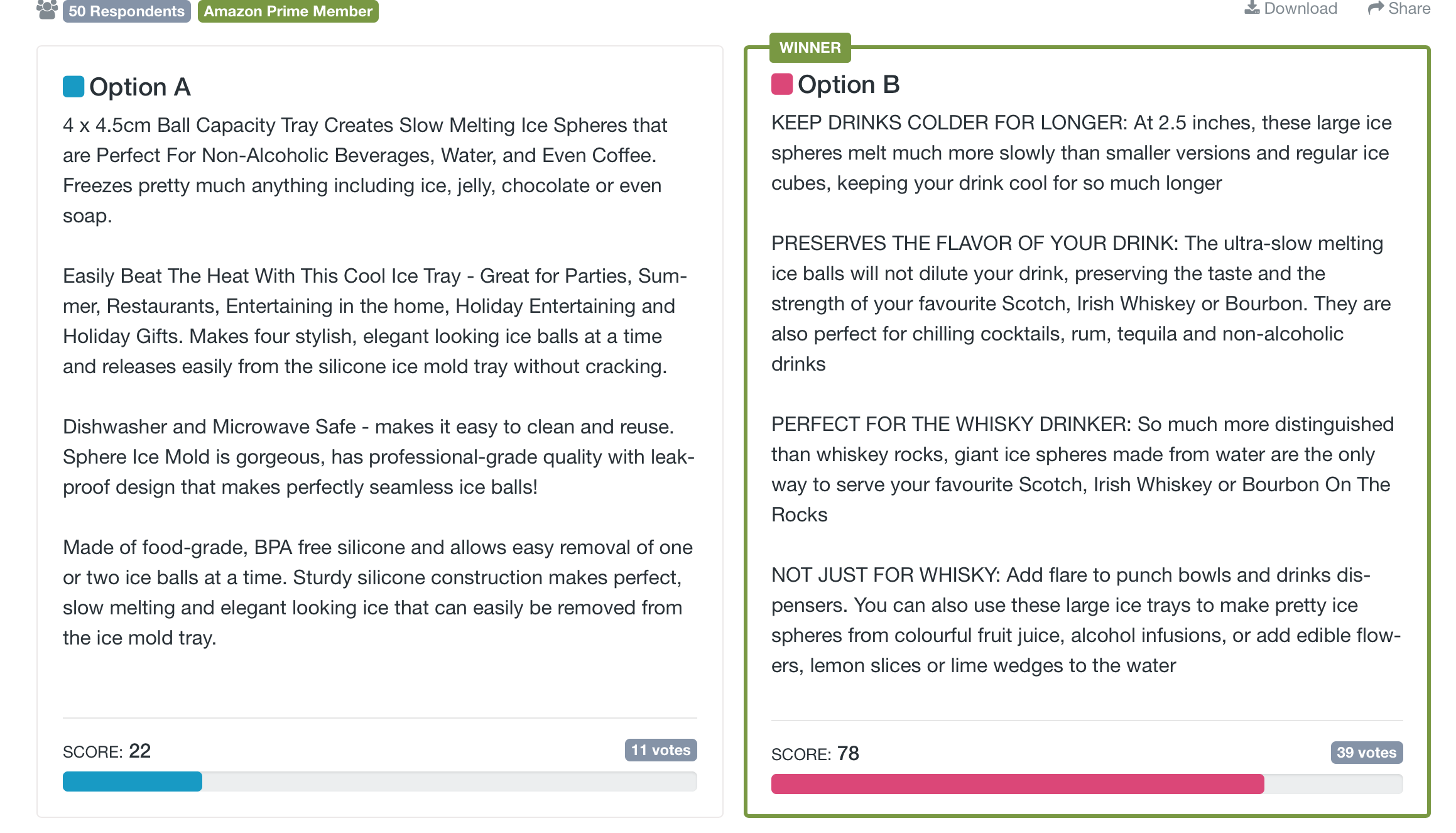On the Business of E-commerce podcast, Charles Palleschi interviews guests to talk about tips, tricks, and strategies to help retailers launch and grow their e-commerce business. Since PickFu plays an important role in e-commerce, Charles asked Kim Kohatsu, PickFu’s director of marketing, to be on the show.
Read on for interview highlights, or watch the entire interview here.

A bit about PickFu
Charles started out the interview by sharing with the audience that he’d asked Kim on the show to talk about how audience members can optimize their product listings. He asked Kim to tell the audience a bit about PickFu.
PickFu, Kim said, is a surveying software that you can use for market research. Instead of just having you build a survey, PickFu brings you a pool of respondents. Those respondents can match your target customer. Need dog owners? Health nuts? PickFu can bring those people to you quickly to answer your poll and help you improve your products and listings.
PickFu is also perfect for a competitive environment. For example, you can put your product packaging up against a competitor’s and ask, “Which one is more appealing?”
And then there’s split-testing, Charles said. Split-testing is necessary to build a successful brand, but it can take a long time if you’re a small brand. On the other hand, if you’re a large brand and you’re seeing some success, you might not want to risk losing business through live split-testing.
The nice thing about PickFu is you can test things before they go live. PickFu helps you figure out the best choices before production or commitment to inventory. A quick poll can test what product variations are the most popular.
Kim brought up an example from PickFu where someone was selling a mattress. This mattress was supposed to be a premium product at an affordable price. The seller tested two names: BudgetBed versus Ebb&Flow.
People hated BudgetBed because it sounds cheap.
These are insights you can only get by putting your idea in front of people.
Once you’ve got your product name, PickFu can help with the main product photo, the language in the product description, the packaging, even the URL.
And even once you’ve been up and running for a while, Charles added, you should revisit older ads to make sure they’re still top-notch.
PickFu is a good way to run tests outside of the marketplace. You don’t just get a vote tally — you get super valuable written comments, too.
Top three things to start testing
Charles asked Kim for insights on how to start testing on PickFu. What, he asked, are the top three things to start testing?
Kim provided her top three for e-commerce:
- Product name — it’s crucial for branding.
- Main product photo — has a huge impact on click-through rate and appeal.
- Language in the product description.
In addition, if you own your own store, make sure your site is as friendly and trustworthy as possible. How is your user interface (UI) layout? This is where you can start thinking about and testing your buttons and fonts.
Charles then asked if Kim recommends going with your brand’s current title and placing options with small tweaks beside it for a split-test. Or should you test a bunch of wildly different photos?
If you’re starting from scratch, Kim said, be broad. Look at different concepts. If you’re doing a product description test, hire three different writers to approach it. Put those up against the existing description. You’ll find a recurring theme and reactions from PickFu respondents that help guide the process.
And since it’s not a live test, there’s nothing to lose!
Surprises within the poll results
In polls, Kim said, there’s always something that surprises her. Many times she’s sure one thing is going to win, and then it doesn’t. Also, unforeseen problems come up with a product description or image.
When you run a poll before a large group of people, those respondents will see things you didn’t. They’ll point things out that you hadn’t noticed — both good things and bad things about your design.
An ad might be great, but over time it starts drifting, Charles added. Split-testing is almost hygiene. You’ve got to keep testing to see if the market has changed — or if your product’s position within the market has changed.
So what kind of test size makes a poll valid?
Unlike live split tests, surveying has a different threshold for validity. In a live test, customers don’t realize there’s another variation. They’re just browsing and shopping as usual. Because of that, the threshold is higher.
With surveying, on the other hand, 50 written responses can give you a compass to guide your decisions. And you can always make your sample
And with live split testing, Charles said, you can’t test options side by side. But in PickFu, you can test up to eight options. Every respondent sees every option, which helps pinpoint what’s different about each one.
What are some helpful questions to ask on PickFu?
Charles wanted to know how PickFu users can create questions that aren’t pushing for certain answers. In other words, how can you use PickFu to get the answers you need, not just the answers you want?
First, Kim said, use plain, objective language. Don’t say, “How much do you like this thing?” Instead say, “Which of these is most appealing to you?” Or probe in a
It’s also helpful to look through our public poll gallery and see what other people have done. Plus every Wednesday on our blog, we feature a poll and our analysis in a series called Which One Won?.
It’s also helpful, Charles noted, to see what words customers are using in the poll responses. You can build your copy based on that and push those words back at them.
It’s definitely important to see which language they do and don’t respond to, Kim said. Take misspellings or hard-to-pronounce words, for example: sometimes they work, but often they don’t. You might be surprised at what you find
“On my site,” Charles said, “I said we did something ‘automagically.’ I thought it was clever. But I got so many customer feedback messages saying I had a misspelling on my main page. No one else thought it was clever. You don’t realize things like that if you don’t test them first. Until people started emailing me words they didn’t like in the copy, I didn’t know.”
With PickFu, you hear that a lot sooner. But how do people do this with Amazon? Charles pointed out that sellers don’t really have control of the listing.
How can Amazon sellers split-test?
A lot of Amazon tests are based on images because images profoundly affect CTR. A lot of times you might have eight product photos to choose from and you pick one you liked best or uploaded fastest. Take those images to PickFu and ask which one respondents would be more likely to click on, and you’d be surprised at what they say.
Take this example from an e-commerce poll testing a fitness band. One photo showed a typical-looking woman using the band. The other image showed more skin, was sexier.
Interestingly, the demographic breakdown showed men liked the one with more skin, but women were quite turned off by it.
Because the product looked like it was geared toward women, it’s possible that even though Option B won, you’d want to go with Option A because women liked it better.
If you’re selling a high-end product, ask yourself this: Which image looks more luxurious? Well-made? High-end?
If you’re launching an Amazon FBA product, product names are crucial. You want to stand out in some way. Product-title calculators will give you tons of optimization keywords. But when it comes to your
Descriptions matter, too. One Amazon seller tested two product descriptions: one without bullet points in all caps, and one with bullet points in all caps.
That was an Amazon description you can see live now. It’s now an Amazon Choice product.
Are PickFu respondents nice or honest?
Kim said that respondents tend to be thoughtful and brutally honest. You’re more likely to get nice feedback if you ask family and friends. Another concern people have is, it’s the internet. What if I get spammy answers?
At PickFu, we have quality controls in place to weed that out. We’ve done a lot on the back-end to make sure people are who they say they are and take questions seriously. If our AI doesn’t think a response is detailed enough, the response won’t go through.
As you run polls, you can also tell us which responses were not helpful or not serious and flag them. We can then take action to refund for that response and ban the person from the system. We have worked to get a solid community of people
Any other surprises or takeaways?
One useful thing that sellers sometimes don’t think about is that you can test an idea before you sell anything. Idea validation is a perfect use for PickFu. Ask, Does anyone need this? Would you pay x dollars for this? Idea validation is one of the most useful but underutilized uses for PickFu.
Even when you already have a group of people who’ll give you decent feedback, PickFu is a good gut-check. One author had a Facebook fan group, and she did a test to see what people would say if she redesigned her book covers. She also ran a PickFu poll.
Her Facebook fan group responded similarly to her PickFu audience. The PickFu audience can be predictive of what you might see in a live test or with customers.
If you use a surveying software like PickFu, it’s easy to get feedback and improve your product before signing off on final designs. You can be confident in the direction you’re going in.
To learn more, head to PickFu.com/ecommerce. PickFu’s also on all social media. And remember to check out our blog and featured polls. Look at other polls people have run and try them out for yourself!







